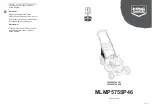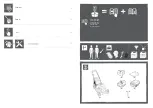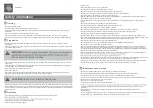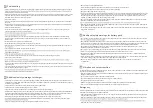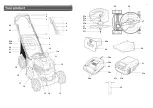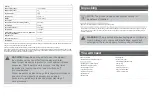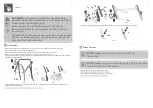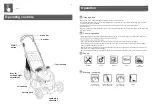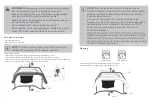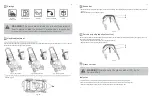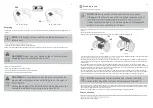
6
05
Fuel handling
• Always switch the product off, disconnect the spark plug connector and let the product cool down before refuelling it. Fuel and fuel
•
There is a risk
of ignition. Remove spilled fuel carefully from all parts of the product. Any residue which may be present must have completely
volatilised, before the product is put into operation!
• Never refuel indoors.
• Never use the product in environments where there is a risk of explosion. Exhaust gases and fuel fumes are noxious. Fuel fumes
can ignite.
•
or sheds. There is a risk of poisoning and explosion!
• Avoid skin contact with petrol.
• Do not eat or drink, while you are refuelling the product. If you have swallowed petrol or oil, or if petrol or oil has got into your
eyes, then seek the advice of a doctor immediately.
•
•
• Fuel vapour pressure may build up inside the fuel tank depending on the fuel used, weather conditions and the tank venting
system. To reduce the risk of burns and other personal injuries, remove the fuel cap carefully to allow any pressure build up to
release slowly.
•
• Do not smoke while operating the product, handling fuel or near fuel.
• Ensure the spark plug lead is secured; a loose lead may cause electrical arcing that could ignite combustible fumes and cause a
• Check regularly for leaks from the fuel cap and fuel lines.
•
before starting the engine.
•
• Do not operate the product if it is leaking fuel. Do not remove the fuel tank cap while the engine is running.
• Use only an approved container.
•
• If any fuel spillage occurs during refuelling, use a dry rag to wipe up spills and allow remaining fuel to evaporate before turning the
engine on again.
• If you have spilt fuel on yourself or on your clothes, change your clothes and wash any part of your body that has come in contact
with fuel before turning the engine on again.
•
.
• If the fuel tank is drained, this should be done outdoors.
06
Additional safety warnings for charger
• This charger is not intended for use by persons (including children) with reduced physical, sensory or mental capabilities, or lack
of experience and knowledge, unless they have been given supervision or instruction concerning use of the appliance by a person
responsible for their safety.
• Children should be supervised to ensure that they do not play with the charger.
• Cleaning and user maintenance shall not be made by children.
• The power cord cannot be replaced. If the cord is damaged the charger should be scrapped.
• Disconnect the charger from the power supply and allow it to cool down before cleaning, maintenance, storage and transportation.
• Protect the electrical parts against moisture. Do not immerse such parts in water or other liquids to avoid electrical shock. Never
hold the charger under running water. Read the instructions provided in the chapter “Care and maintenance”.
• Before using the charger, read all the instructions and cautionary markings on the charger and battery pack.
•
. Only use the charger IS12C with the
• Charge the battery pack indoors only as the charger is designed for indoor use only.
7
• Do not charge non-rechargeable batteries.
• Protect the charger against moisture and wet conditions. There is a danger of electric shock.
• Do not place any object on top of the charger as it could cause overheating.
• Do not place the charger near any heat source.
•
electric shock or electrocution. If an extension cord must be used, ensure: pins on plug of extension cord are the same number,
size and shape as those plug on the charger; extension cord is properly wired and in good electrical condition; wire size is a
minimum of 16 AWG to allow for AC ampere rating of the charger.
• Do not use the charger if it has been subjected to a heavy knock, dropped or otherwise damaged in any way. Have the charger
checked and repaired by an authorised service centre.
•
• Disconnect the charger from the power supply before attempting to clean it to reduce the risk of an electric shock. Removing the
battery pack alone does not reduce the risk.
• To reduce the risk of damage to the power cord and plug, always pull the plug rather than the power cord when disconnecting the
charger from power supply.
07
Additional safety warnings for battery pack
• Do not attempt to charge the battery pack with any other charger than the one supplied. The charger and battery pack supplied
• Small leakage of liquid from the battery pack may occur under extreme usage or temperature conditions. However, if the outer
seal is broken and this leakage comes into contact with your skin, wash the affected area quickly with water. If the leakage gets in
• Never attempt to open the battery pack for any reason. If the plastic housing of the battery pack breaks open or cracks,
immediately discontinue its use and do not recharge it.
• Do not store or carry a spare battery pack in a pocket or toolbox or any other place where it may come into contact with metal
• Do not pierce the battery pack with nails, strike the battery pack with a hammer, step on the battery or otherwise subject it to
strong impacts or shocks.
• Protect the battery pack against heat. Do not place the battery pack in direct sunlight or use or store the battery pack inside cars
in hot weather. Doing so may cause the battery pack to generate heat, explode or ignite.
• Never try to charge a battery pack that is cracked or damaged in any other way. There is a danger of electric shock
or electrocution.
08
Vibration and noise reduction
To reduce the impact of noise and vibration emission, limit the time of operation, use low-vibration and low-noise operating modes
as well as wear personal protective equipment.
• Take the following points into account to minimise the vibration and noise exposure risks: Only use the product as intended by its
design and these instructions.
• Ensure that the product is in good condition and well maintained.
• Use correct attachments for the product and ensure they are in good condition.
• Keep tight grip on the handles / grip surface.
• Maintain this product in accordance with these instructions and keep it well lubricated (where appropriate).
• Plan your work schedule to spread any high vibration tool use across a longer period of time.
Emergency
Familiarise yourself with the use of this product by means of this instruction manual. Memorise the safety directions and follow them
to the letter. This will help to prevent risks and hazards.
•
Always be alert when using this product, so that you can recognise and handle risks early. Fast intervention can prevent serious
injury and damage to property.
• Stop the engine and disconnect the spark plug connector / remove the battery pack if there are malfunctions. Have the product
•
product switch is no longer accessible.

